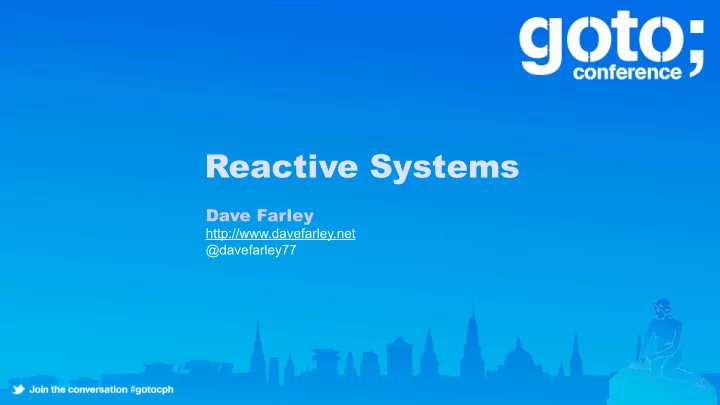

Reactive Systems Dave Farley http://www.davefarley.net @davefarley77
Reactive Systems 21st Century Architecture for 21st Century Problems Dave Farley http://www.davefarley.net @davefarley77 http://www.continuous-delivery.co.uk
Our World Is Changing Large Applications circa 2005: 10’s of Servers • Seconds of Response Time • Hours of Offline Maintenance • Gigabytes of Data • Large Applications Now: Handheld Devices to 1000’s of multi-core • processors Millisecond Response Time • 100% Uptime • Petabytes of Data •
Our World Is Changing
The Reactive Manifesto “21st Century Problems are not best solved with 20th Century Software Architectures” Responsive Elastic Resilient Message Driven The Evolution of modern hardware has changed many of the common assumptions of software development Source: www.reactivemanifesto.org
Reactive Systems Are: Responsive: • Responds in a Timely Manner • Cornerstone of Usability • Also Quick to Detect Problems
Reactive Systems Are: Resilient: • Remains Responsive in the Face of Failure • Resilience Depends on - Replication, Containment, Isolation and Delegation
Reactive Systems Are: Elastic: • Remains Responsive Under Varying Workload • Responds to Change in the Input Rate By Increasing or Decreasing Resources that Service the Input • Decentralised Architecture, No Contention Points, No Central Bottlenecks
Reactive Systems Are: Message Driven: • Asynchronous Message Passing is the foundation for all of these properties • Loose-Coupling, Isolation, Location Transparency • Ability to Delegate Errors
Properties of Reactive Systems • Flexible • Loosely-Coupled • Scalable • Easier to Develop • More Tolerant of Failure • Respond to Failure Gracefully • Responsive to Users
Fractal Architecture • Large Systems Are Composed of Smaller Ones • They Depend on the Reactive Properties of Their Constituents • These Benefits Operate At All Scales • Such Systems are Composable
Failure Modes in Synchronous Messaging Component ‘A’ Component ‘B’
Synch Messaging Breeds Complexity Component ‘A’ Component ‘B’ Synchronous Comms Increases Coupling in Location and Time
Synch Messaging Breeds Complexity Component ‘A’ Component ‘B’ ?
The Benefits of Asynchrony Single Threaded! Single Threaded! Component ‘A’ Component ‘B’
An Example Order(“Continuous Delivery”) Reserve(“Continuous Delivery”) Component ‘A’ BookStore Component ‘B’ Inventory Order(“Continuous Delivery”) Reserve(“Continuous Delivery”) Ordered(“Continuous Delivery”) Ordered(“Continuous Delivery”)
An Example Order(“Continuous Delivery”) Order(“Better Aerobatics”) Reserve(“Continuous Delivery”) Reserve(“Better Aerobatics”) reserving reserving ordered ordered BookStore Inventory Ordered(“Continuous Delivery”) Ordered(“Better Aerobatics”) Ordered(“Continuous Delivery”) Ordered(“Better Aerobatics”)
An Example of Idempotence Component ‘A’ 1 2 7 8 1 2 7 8 1 2 4 3 4 2 1 3 5 3 6 3 6 3 5 4 5 4 5 4 Component ‘B’ Expected(3) 7 8 1 2 1 2 7 8 1 2 3 6 3 3 6 3 5 4 5 4 5 4
Isolation • Decoupling in Time and Space Time - Sender and Receiver have independent lifecycle • Space - Location Transparency • • Share Nothing! • Built on Inter-Component Communication over Well Defined Protocols
Isolation Component ‘A’ Component ‘B’
Share Nothing Component ‘A’ Component ‘B’
Back-Pressure • You Can’t Isolate Stress • The System as a Whole Needs to Respond Sensibly • Unacceptable For a Stressed Component to Fail Catastrophically or Loose Messages • Queues Represent An Unstable State - Load • Components Under Stress Need to Reflect This By Applying Back-Pressure, Slowing Upstream Inputs
Queues Represent an Unstable State Queues are always full or always empty. Anything else is transitional, on its way to full or empty. Component ‘A’ Component ‘B’ Always Empty! Slightly Slower Slightly Faster
Queues Represent an Unstable State Queues are always full or always empty. Anything else is transitional, on its way to full or empty. ? Component ‘A’ Component ‘B’ Always Full! Slightly Faster Slightly Slower
Back-Pressure re! Component ‘n’ Back-Pressure! Component ‘A’ Component ‘B’ Always Full! Slightly Faster Slightly Slower
Eventual Consistency Component ‘A’ Component ‘B’
Location Transparency • Elastic Systems Need To React To Changes In Demand • We Are All Doing Distributed Computing • Embracing This Means There Is No Difference Between Horizontal (Cluster) and Vertical (Multicore) Scalability • Components Should Be Mobile • One Pattern For Communications Local Communications Is An Optimisation •
Linear Scalability Through Sharding Component ‘A’ Component ‘B’
Linear Scalability Through Sharding Component ‘B 1 ’ Component ‘A’ Component ‘B 2 ’
Modern Hardware Should Change Our Assumptions • For Efficient Software, The Biggest Cost is Shifting Data • RAM is Not Random Access • Disk is Not Random Access • SSD is Not Random Access • RAM is Slow, Network is Slow, Disk is Slower
Conway’s Law UI Specialists Middleware Specialists DB DB Specialists Siloed Teams Rigid Architecture
Conway’s Law Cross-Functional Distributed Service Teams Architecture Organised by Business Function
Bounded Contexts • Each Component Is Autonomous and Isolated • It Only Communicates Through Well Defined Protocols • Works Best When Components Are Aligned With Bounded Contexts • Bounded Contexts Are A Concept From Domain Drive Design (DDD) - Eric Evans • Bounded Context: The Context Within Which A Model Of the Problem Domain Make Sense • There Should Be ‘Translations’ Between Bounded Contexts - No “One Model To • Rule Them All” Bounded Contexts Tend To Align With Business Functions • Best Way To Decompose Organisations And Systems •
Example Reactive, MicroService architecture Public API Market Data Market Consumers Makers Clearing TFX Notification FIX Gateway Services Public Gateways Application Service Gateways Web App Public Message Bus Execution Execution Venue Execution Execution Venue Execution Core Services General Services Management Service Execution Venue Management Service Trade Report Management Service Account Instrument Contact Payment (Markets & Matching) Service Service Service Service Service (Accounts & Positions) Control Message Bus Market Customer Gateway Services Notification Management Service Market Service Customer Application Management Application Service
Where to start?
Q&A http://www.continuous-delivery.co.uk Dave Farley http://www.davefarley.net @davefarley77
Recommend
More recommend